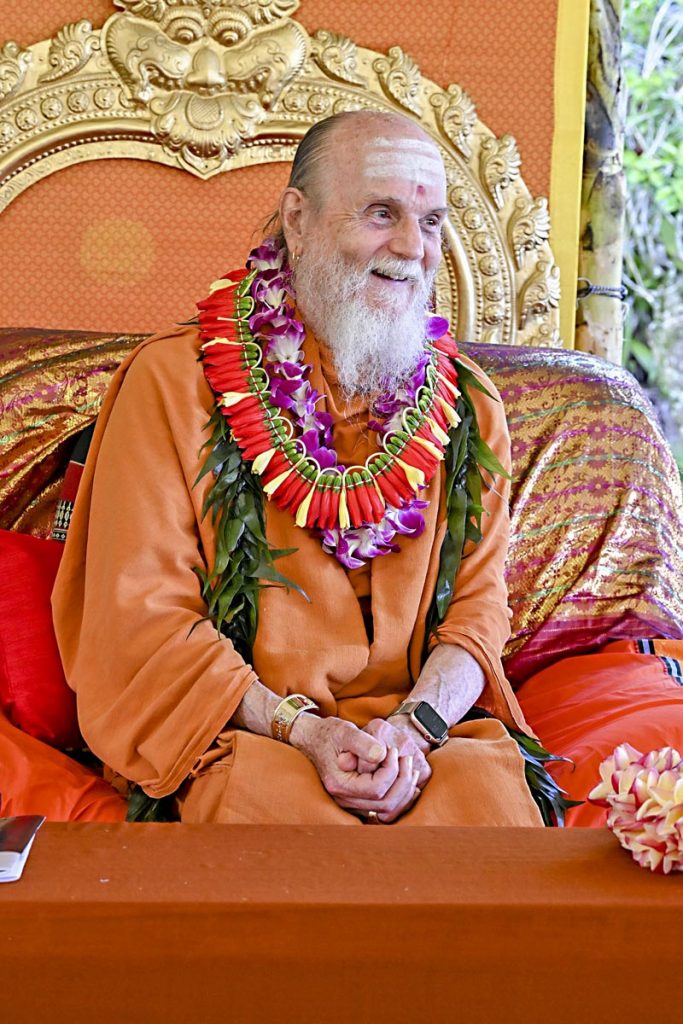Exploring real happiness—which does not fade with time, does not rely on novelty or material gain, does not tire of itself
By Satguru Bodhinatha Veylanswami

I know a spiritually awesome individual. He is able to quickly calm himself when upset, to transform unhappiness into happiness, to inspire those who are discouraged, and always finds time to listen to the stories and concerns of family and friends.
Would you like to be introduced to this amazing person? It’s easy. Just look into a mirror. Yes, that awesome person is you. But it is not the outer you—the body, the intellect or the emotions. It is the spiritual part of you, the soul, the atman, the immortal presence you can sense by looking into your eyes.
Most religions believe that man has a soul, a divine aspect to his existence. Hinduism has always held this belief. As the Vedas say, “One should meditate on the atman, which consists of spirit, whose embodiment is life, whose form is light, whose essence is space, which changes its form at will, and is swift as thought” (Shukla Yajur Veda, Shatapatha Brahmana 10.6.3.2).
Each of us is a soul, a divine being presently inhabiting a physical body. At the deepest level, we are pure, radiant and blissful. That is our spiritual or intuitive nature. We also have an instinctive nature and an intellectual nature. Thus our nature is three-fold: instinctive, intellectual and intuitive. Let’s look more deeply at each of these.
The instinctive nature embodies our lower, animal functions—self-preservation, procreation, hunger and thirst—as well as the base emotions, such as greed, hatred, anger, fear, lust and jealousy. This phase of mind functions automatically.
My guru, Sivaya Subramuniyaswami, gave the following description of our intellectual and intuitive aspects. “The intellectual nature is a mixture of man’s instinctive desires and cravings coupled with the knowledge he has gained from others and from his own intuitive discoveries. Within man’s intellect, he organizes a vast amount of knowledge that begins to accumulate from a very early age. Ninety percent of this knowledge deals with the externality of the world and mind itself.
“The intuitive, or superconscious, nature is even more complex, more organized, more refined than the instinctive or intellectual phases. It is mystically known as the mind of light, for when one is in this state of mind, he may see light within his head, and sometimes throughout the entirety of his physical body, if his inner sight is developed enough. Otherwise, he just begins to feel good all over, as actinic energy permeates his nervous system. Its most refined essence is Satchidananda, all-knowing, omnipresent consciousness, the one transcendental, self-luminous, divine mind common to all souls. When intuitive flashes come, one knows the next thing to be done in a creative activity.”
Hinduism does not stop at simply asking you to believe in the existence of your soul and intuitive nature. It gives you practices to help you experience and live in your soul nature on a daily basis. In fact, we could say discovering and then regularly re-experiencing the truly spiritual being within you, the atman, is what Hinduism is all about. A wonderful byproduct of this practice is that, over time, the perspective of being your soul, your intuitive nature, becomes stronger and stronger as your identification with the outer instinctive-intellectual nature gradually diminishes.
Let’s look at how experiencing the atman relates to an important goal that all people are pursuing—happiness. The popular expectation is that happiness automatically comes upon achieving one’s professional and family goals. Many adults have told me that they are surprised that even though they have, after many years, achieved career, financial and family goals they thought would make them happy, they find they are not. Swami Chinmayanandaji, founder of Chinmaya Mission, poignantly observed: “The tragedy of human history is decreasing happiness in the midst of increasing comforts.”
Webster’s dictionary tells us that happiness is the emotion evoked by success or by the prospect of possessing what one desires. Individuals who have given deeper thought to the subject understand that such happiness does not last. Depending on the source, this happiness fades within a few days, weeks or months at best. Then one is back in the state of feeling dissatisfied and seeking something external to provide fulfillment.
If the world cannot provide lasting happiness, where else is there to look? An abundance of verses in Hindu scripture provide the answer clearly and repeatedly: the only enduring happiness is inside of us, in our spiritual nature, in our soul.
The Mundaka Upanishad (3.11.1-2) presents this truth in a story. “Two birds, united always and known by the same name, closely cling to the same tree. One of them eats the tree’s sweet fruit, while the other looks on without eating. While enjoying the fruit, the first bird moans, bewildered by his limitations. But when he beholds the Other, the glorious Lord worshiped by all, he becomes freed from sorrow.”
Spiritual happiness has a name in Sanskrit: sahajananda. Sahaja means that which is inherent, innate or natural. Ananda means bliss, happiness or joy. Thus, sahajananda is our inherent or inmost happiness. Sivaya Subramuniyaswami comments on this idea, “Learn to be happy by seeking happiness, not from others, but from the depths of the mind that is happiness itself.”
I often stress that in Hinduism each teaching has two aspects. The first is the intellectual concept to be understood, which in this case is that lasting contentment is inside of us. The second aspect is the experience of the concept. Understanding needs to lead to experience, and experience comes through consistent practice over time.
Based on Gurudeva’s teachings, there are various types of practice that lead to experiencing inner, lasting happiness. The first is meditation. A good meditator can turn within deeply enough to experience the energy, light and joy of the soul nature. Paramaguru Yogaswami described this in one of his songs: If you “practice Sivadhyana, meditation on Siva, daily you will enjoy happiness in your inmost soul, and the thought that the well-being of others is your own will flood your heart.”
A second practice involves attending puja at a Hindu temple. This is a devotional approach in which we focus on filling ourself with the blessings emanating out from the Deity during the highpoints of the puja. Those blessings, which Gurudeva called the darshan or shakti of the Deity, can internalize our awareness to reach the same inner depth as is possible in meditation.
Success at this method requires feeling devotion for the Deity and concentrating or paying attention to the ceremony. The importance of one-pointed presence is illustrated in an analogy. Most everyone has a favorite music which uplifts them. However, if the music is playing and the person is thinking about something else, the music does not inspire. It is just background sound.
Attending puja works the same way. If we pay attention, we receive the Deity’s blessings, feel uplifted and experience our inner happiness. If we are mentally engaged in something else, we miss the divine presence before us.
A third practice is helping other people, being of service, performing seva. This is altruism, which Webster’s dictionary defines as “unselfish regard for or devotion to the welfare of others.” When we get involved in the needs of others and provide for those needs through service, our awareness moves out of the area of personal concerns into an altruistic perspective which is an expression of our soul nature.
Gurudeva made an insightful statement about selfless service: “Go out into the world this week and let your light shine through your kind thoughts, but let each thought manifest itself in a physical deed of doing something for someone else.… Through service and kindness, you can unwind the subconscious mind and gain a clear understanding of all laws of life. Your soul will shine forth. You will be that peace. You will radiate that inner happiness and be truly secure, simply by practicing being kind in thought, word and deed.”
The abilities described here are all within your reach by experiencing your atman on a regular basis through meditation, temple worship and selfless service. Experiencing the atman not only brings happiness to you but also brings a desire to share it with others. By claiming your spiritual nature, you naturally learn to quickly calm yourself when upset, to transform unhappiness into happiness, to inspire others when they are discouraged and to always find time to listen to the concerns of family and friends.

Thank You Swamiji.
I am very grateful for the spiritual guidance provided by yourself and Hinduism Today.
Following the guidance has been greatly uplifting.
I have found the trilogy Dancing with Shiva, Living with Shiva and Merging with Shiva to be very illuminating and uplifting.
I am located in India, however my heart is uplifted from a distance thinking about the amazing thoughts revealed in The Himalayan academy.
Live, learn and practice spirituality as guided by Shaivism and Hinduism Today has been very uplifting and rewarding.
With lots of love and gratitude,
Pritpal Dhaliwal.
Learning this article changed a lot of things for me. I was feeling sad and felt so lazy. Now I feel uplifting. Something I would remember is to practice being kind in thought, word and deed.
Thank you beloved Satguru, always explaining with incredible clarity about our internal universes. We are greatly blessed to have the grace to listen to you and follow you.
Aum Namah Sivaya